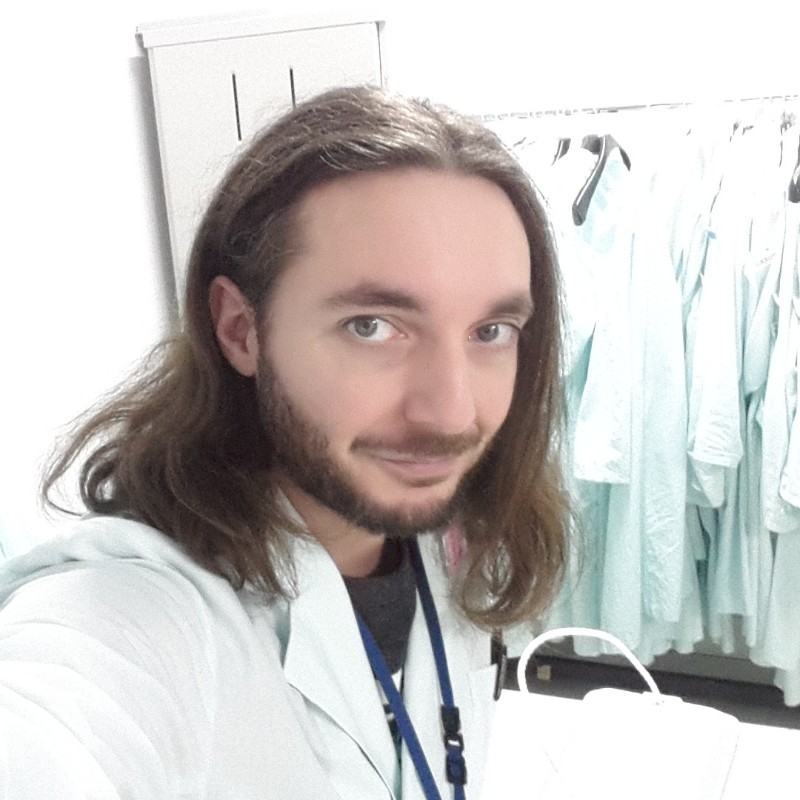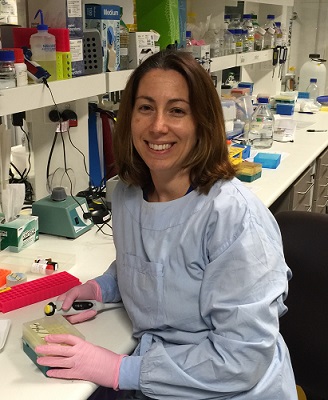Grants
The DIPG / DMG Collaborative has funded $18,373,550 in DIPG/DMG research.
Interested in applying for a grant from the DIPG / DMG Collaborative? Learn more.

Johns Hopkins Hospital – $100,000
$100,000.00
December 2024
Leveraging Epigenetic Alterations for Therapy of Diffuse Midline Glioma
Diffuse midline glioma (DMG) is a uniformly fatal brainstem tumor of childhood with no effective therapies. Given the failure of chemotherapy and radiation against DMG, we are pursuing strategies to enable effective immunotherapy for this disease. A major roadblock to immunotherapy is that DMG cells effectively ‘hide’ from the body’s immune system. We now understand that DMG cells rely on “epigenetic” modifications, or chemical marks that regulate whether genes are turned on or off. This presents a selective vulnerability in DMG cells that makes them sensitive to epigenetic drugs. We have shown that use of existing, FDA-approved drugs to target epigenetic regulators can activate immune signaling in DMG cells and cause expression of new targets that can be recognized by the immune system, creating an avenue for converting this immunologically ‘cold’ tumor into a ‘hot’ one that can be effectively targeted. In order to validate this strategy for translation to patients, it is necessary to use a mouse model with an intact immune system, unlike the immunodeficient mouse models that are typically used to model human brain tumors. We will employ a powerful DMG mouse model in collaboration with Dr. Oren Becher in order to test the effect of epigenetic therapy on immune signaling in DMG, with the goal of rapid translation of these therapies to patients who urgently need better treatments.

Children’s Hospital of Philadelphia – $100,000
$100,000.00
December 2024
Cytokine Signaling in Diffuse Midline Glioma to Enhance GD2-Directed CAR T Cell Trafficking
Diffuse midline glioma (DMG) is a devastating brain and spinal cord tumor that occurs in children and is universally fatal, killing most patients within one year. New approaches using the body’s immune system to attack DMG have started to show promise for patients. Chimeric antigen receptor or “CAR” T cells are an immune based cancer treatment that involves taking white blood cells from a patient, reprogramming them to seek out and attack tumor cells, then reintroducing these cells back into the patient where they destroy the cancer. One type of CAR T cell seeks out a target called GD2, a sugar molecule that sits on the outside of DMG tumor cells. Using GD2-seeking CAR T cells in mouse models, we observed that they work best when the first dose is given directly into the tumor, followed by doses into the fluid that coats the brain and spinal cord. The CAR T cells in the tumor seem to be sending a signal to the subsequent CAR T cells in the fluid, recruiting them to come fight the tumor as well. The goal of this proposal is to better understand the immune signals coming from DMG tumors and active T cells to help design the best CAR T cell trial for patients.
First, we will evaluate the blood and cerebral spinal fluid from 10 patients with DMG specifically looking at proteins related to the immune system. We will then use patient tumor cells and CAR T cells in the lab to identify what immune proteins are released when CAR T cells encounter and kill DMG tumor cells. Thus, this proposal aims to understand the baseline immune system of DMG patients, and how the signals from the immune system change after tumor cells encounter CAR T cells. Our goal is to create optimal dosing strategies of GD2-seeking CAR T cells and design better CAR T cells for clinical trials to help cure these awful tumors in children.

UNC Eshelman School of Pharmacy – $50,000
$50,000.00
December 2024
Leveraging Open Science and Collaboration to Identify Clinical Quality ALK2 Inhibitors for DIPG
Diffuse intrinsic pontine glioma (DIPG) is a rare, fatal brain cancer for which there are no good treatments. Part of the problem is that, doing business as business is currently done, there are no financial incentives for discovering medicines for DIPG. Traditional companies see that potential for return on investment is low due to the high failure rate of medicines in the clinic, the low patient population, and the added difficulties of treating children. Financial incentives should not be the barrier that stops the identification of life saving medicines: the need for effective treatments for these children is paramount. Since current business models do not support DIPG drug discovery, new business models are clearly needed, and this is a key to our approach. We are part of a global team, working under the umbrella of M4K pharma, using open science and collaboration to revolutionize the way affordable new medicines are discovered and developed. Kinases are important and attractive drug targets, and over 80 kinase inhibitors have been approved by the FDA for clinical use. Evidence suggests that the kinase ALK2 is an excellent target for DIPG drug discovery. Our goal is to advance an ALK2 inhibitor into clinical trials.
Our M4K team has identified a selection of high quality ALK2 inhibitors and are triaging them to determine whether we have a suitable clinical candidate that meets our high standards. These include excellent ALK2 inhibitory potency in cells, high selectivity over other kinases, and chemical properties that will allow for oral dosing, safety, and delivery of high concentration to the region of the brain where the tumor is located. In parallel to our ongoing analysis of current compounds, we are designing and making new inhibitors of ALK2 in case no current compound meets our high standards, and to provide a backup compound if we determine that we already have a compound that is suitable for advancement. This application, “Leveraging open science and collaboration to identify clinical quality ALK2 inhibitors for DIPG” seeks funding to help us with our goal of discovering effective, safe, and affordable medicines for DIPG patients. The Drewry lab seeks funding for two specific aims. In aim 1 we will screen ALK2 inhibitors from all M4K partners in our state-of-the-art NanoBRET cellular assays, for both our primary target ALK2, and off target kinases that we need to have selectivity over. The data generated in this assay is critical to our overall mission. In aim 2 we will design, synthesize, and evaluate new compounds designed to be address issues and potential issues in our current compounds.

Murdoch Children's Research Institute – $100,000 USD / $156,914 AUD
$100,000.00
December 2024
Harnessing Developmental Neurobiology to Reprogram the Cell of Origin of Diffuse Midline Gliomas
Transcription factors can be considered as “molecular switches” that can turn ON or OFF specific sets of genes. The overall objective of this project is to understand how the gene networks up- and downstream of the transcription factor DLX2, and how changes to DLX2 itself, affect brain and DMG development. This will be accomplished in two scientific aims: In Aim 1, we will use advanced genomics and gene-editing technologies to investigate the developing mouse brain (collected from developing mouse embryos). We will determine what other proteins and genes change the behaviour (or function) of DLX2, as well as what proteins and genes are impacted by DLX2. This will help us understand the networks that regulate DLX2, and how normal and abnormal brain development in this region of the brain occurs. In Aim 2, we will manipulate DLX2 in cells that are derived from the DMG tumors of patients, to determine how the cell growth is impacted by changes in DLX2. These manipulated DMG cells will be observed in cell-culture (in vitro) and in live mice where these modified DMG cells have been surgically implanted into newborn mouse brainstem (in vivo).
Despite significant efforts, there has been no improvement in the treatment and outcomes for DIPG (diffuse intrinsic pontine glioma)/DMG (diffuse midline glioma) in the past 50 years. In 2012, the co-discovery that the majority of DMG, including DIPG, have specific mutations of variant histones (known as H3.3 and H3.1) fundamentally changed what we know about these tumors, and as a result, many researchers have redirected their efforts to systemically unravel the underlying biology and to apply these learnings towards the development of new therapies.
Histones help to “wrap” our DNA so that it fits inside the nucleus of the cell. Changes to histones, known as histone modifications, further assist to “unwrap” or “wrap” specific regions of the DNA within the nucleus of the cell so that specific genes or sets of genes can either be expressed or are blocked from being expressed. The more recent application of single cell genomics platforms using DMG samples, including RNA sequencing, support that there is a specific cell of origin for DMGs, an oligodendroglial progenitor cell (OPC). In the adult brain, OPCs eventually become oligodendrocytes that make myelin, a substance that insulates the projections of other brain cells called neurons and coordinates brain function. However, current and proposed therapies for DMG do not target this cell of origin. Our novel work in the emerging field of Cancer Neuroscience addresses the developmental neurobiology of these tumors and through sophisticated and comprehensive analysis of genetic and epigenetic networks and structures, as well as new models (using cell culture and mouse models), we will unlock the underlying biological basis of these tumors towards approaches to novel therapies for DMG.
The Eisenstat laboratory is one of three labs in the world that are expert in understanding the role of the distalless (DLX) class of transcription factors in brain development and the only one focused on applying this knowledge to help solve DMG. The Neuro-oncology laboratory based at the Murdoch Children’s Research Institute (MCRI) and the Brain Cancer Research laboratory based at the Walter and Eliza Hall Institute (WEHI), both affiliated with the University of Melbourne, Australia, have the specialised skillsets and laboratory platforms to perform this work. The MCRI has established and maintained the genetically engineered mouse models lacking Dlx gene function, and has the expertise required for the genetic manipulation of DMG cell lines, including advanced gene editing techniques known as CRISPR. The MCRI also has access to multiple cell-lines derived from patients with DMG which will be used for the these experiments. The WEHI has the specialised equipment required for performing the newborn mouse implantation experiments, as well as the required imaging technology to visualise the tumor development in live mice.
Ultimately, Aim 1 will provide a comprehensive understanding of the role DLX2 plays in normal brain development (and how it interacts with other transcription factors), while Aim 2 will apply this knowledge to how varying levels of DLX2 impacts DMG development. These findings will inform future experiments at the MCRI, including more complex cell culture experiments and sophisticated characterisation of the DLX2 protein itself towards making this transcription factor “druggable”. Our longer-term translational goal is to alter the level of DLX2 in patients with DMG as a novel form of differentiation therapy, so that we may take advantage of the underlying developmental neurobiology of the tumor to change outcomes for DMG patients.

Children’s Cancer Institute – $70,400 USD / $110,467 AUD
$70,400.00
December 2024
A Novel Formulation to Allow the Simultaneous Targeting of MYC Expression and Copper Chelation to Treat DIPG Tumor and Overcome Multidrug Resistance
Diffuse Intrinsic Pontine Glioma (DIPG) is a devastating brain cancer that primarily affects children between the ages of 5 and 10. With a poor prognosis, most children diagnosed with DIPG survive only about 9 to 12 months. Current treatments like radiation therapy offer only temporary relief, leaving families and doctors in desperate need of better options.
Our Innovative Approach
Our research is exploring a novel approach to treat DIPG by combining two promising strategies: copper chelation and gene silencing.
- Copper Chelation: Cancer cells, especially in brain tumors, often contain high levels of copper, which they utilize to grow and resist treatments. We use a drug called TETA to strip the excess copper from the cancer cells, making them weaker and more susceptible to treatment.
- Gene Silencing: The MYC gene is a major player in tumor growth and aggressiveness. By using small molecules called siRNA, we aim to turn off this gene, thereby slowing down or stopping the tumor growth.
The Delivery System
To get these treatments directly to the tumor cells, we use structures made from red blood cells, known as extracellular vesicles (EVs). These EVs act like delivery trucks, carrying our treatments safely through the body to the brain tumor, ensuring they reach their target effectively.
What We Expect
Combining these two approaches, we hope to:
- More effectively stop tumor growth.
- Increase the death of cancer cells.
- Reduce the tumor cells’ ability to survive.
- Prevent the cancer cells from developing resistance to treatment.
Progress So Far
We have made exciting progress from the start of our study in March 2024.
- Producing EVs: We successfully created EVs loaded with anti-MYC siRNA.
- Delivery to Cancer Cells: These EVs effectively delivered the siRNA to DIPG cells in the lab, significantly reducing MYC gene activity.
- Reducing Tumor Growth: This led to a 50% reduction in cancer cell growth. Combining TETA with MYC silencing showed an even greater effect, making the treatment more powerful.
- Developing Tools: We designed a high-throughput device to improve the efficiency of loading red blood cells with our therapeutic molecules, aiming to increase production and reduce costs. This plug-and-play device is capable of collecting blood, loading red blood cells with therapeutics, and releasing extracellular vesicles (EVs) into the patients' veins, embodying a circular personalized medicine approach
The Potential Impact
If successful, our approach could revolutionize DIPG treatment, offering a new, targeted therapy that minimizes damage to healthy cells and reduces side effects. This method could also be adapted to treat other types of cancer by changing the drug and RNA content inside the EVs.
Our vision is to provide more effective and personalized cancer treatments, offering new hope to patients who currently have few options. This research holds the promise of improving outcomes for children with DIPG.

The Institute for Medical Research Israel-Canada – $40,000 USD / 143,580 INS
$40,000.00
December 2024
CXCR1/2 Signaling Pathway: A Role in the Invasive Mechanism of DIPG
High-grade gliomas (HGGs) make up 8-10% of children's brain tumors and are often fatal within two years. These tumors can develop in the cerebral cortex or infratentorial regions like the brainstem. About half of pediatric HGGs occur in midline locations such as the pons, known as diffuse midline gliomas (DMGs), including DIPGs. High-grade gliomas show distinct patterns, with DIPGs typically developing in mid-childhood. DIPGs are highly invasive, making understanding what drives this process to create effective treatments essential.
Our research has shown that, unlike cortical HGGs, DIPGs grow and spread more when implanted into brainstem tissue compared to cortical tissue. Additionally, brainstem microglia (support cells in the brain) enhance the growth and spread of brainstem tumors more than cortical microglia do. This indicates that specific factors in the brainstem environment support DIPGs.
We have identified several genes that are differently expressed between the brainstem and cortical microglia, including CXCL5. This gene is part of the CXCL-ELR+ family, which interacts with the CXCR1/2 receptors and is known to influence cell movement and cancer cell invasion, including in gliomas. Our initial findings suggest that the CXCR1/2 pathway may play a role in DIPG invasion.
With this grant, we aim to test how the CXCR1/2 pathway and related factors contribute to DIPG growth and spread. We will also evaluate whether the key players in this pathway could be potential targets for new DIPG treatments.
Our ultimate goal is to translate these findings into clinical trials, offering new hope to children and families affected by this devastating disease. By supporting our research, you are contributing to the development of targeted therapies that could revolutionize the treatment landscape for DIPG.

Children's Hospital Los Angeles – $100,000
$100,000.00
October 2024
Targeting FOXR2 in Diffuse Midline Gliomas
Diffuse midline glioma (DMG) is a deadly pediatric brain cancer. Despite radiation treatment, nearly all children diagnosed with the disease succumb to it with a median survival of 12 months. There have been few advancements in treatment, and current treatment has no curative intent. Therefore, there is a significant need to develop new therapeutic strategies to improve the terrible outcomes for these children and improve quality of life for patients and their families. Looking at genes that are turned on or off in a particular type of cancer can be helpful to figure out what is causing the cancer to grow. One such gene which we found to be turned on in DMG is FOXR2. Interestingly, FOXR2 is normally turned off in normal brain. We have previously studied how FOXR2 is turned on and off. When it is turned off, DMG cancer cells die. In this project, we will study how to turn FOXR2 off using small interfering RNA (siRNA) that can be delivered to the brain tumor. We will use patient DMG cell models as well as mouse models of DMG. Ultimately, our goal is to determine whether we can target FOXR2 in DMGs to improve outcomes for children and their families impacted by this terrible disease.

University Hospital of Navarra - $100,000 USD, €92,637 EUR
$100,000.00
October 2024
Targeting Diffuse Midline Glioma vulnerabilities as a therapeutic strategy.
Diffuse Midline Gliomas (DMGs), including Diffuse Intrinsic Pontine Gliomas (DIPGs), are among the most aggressive pediatric brain tumors and the leading source of mortality in pediatric oncology. The median life expectancy of these children remains below 14 months after diagnosis, and nearly none survive beyond the second year. All therapeutic approaches have failed, leaving radiation therapy as the sole palliative treatment that transiently ameliorates the disease. Therefore, finding a curative and feasible alternative for these children is of the utmost importance. Delta-24-RGD is an oncolytic adenovirus genetically modified to replicate and kill tumor cells selectively while remaining harmless in normal tissues. This biotherapeutic agent has been recently tested in a small number of DIPG patients, validating its safety and showing clues of efficacy. In addition, analysis of patient samples demonstrated the effect of Delta-24-RGD in activating the patient’s immune response against the tumor. Unfortunately, the effect was only transitory, and all patients recurred. Additional genetic modifications of Delta-24-RGD have been explored to potentiate its anti-tumor effect, such as incorporating immunostimulatory transgenes. Despite these upgraded viruses being more efficient in promoting anti-tumor responses, the effect cannot be curative in all subjects. Here, we propose to refine the design of modified oncolytic viruses by considering the intrinsic peculiarities of DMGs. We will arm this virus with molecules that have the capability to trigger effective antitumor immune responses while maintaining a safe profile. At the end of the project, we expect that the results yielded by this project will show a new, innovative, and efficient therapeutic approach based on oncolytic viruses for DMGs while maintaining a safe profile. These data should place us in a strong position to translate to the clinical scenario a new therapy for children with DMGs, and we expect to find that it offers these children a curative, safe, and feasible alternative.

The Institute of Cancer Research – $111,445 USD / £85,976 GBP
$111,445.00
October 2024
Unravelling transcriptional plasticity as a non-genetic mechanism of drug resistance in DMG.
Diffuse midline glioma (DMG) is a malignant brain tumour arising in children representing a major unmet clinical need, with a 2-year survival rate close to zero. We and others have found that some DMGs have alterations in the MAPK pathway which drives cell growth – drugs targeting this pathway may be initially effective, but eventually the cancer cells escape therapy. We have used DMG cell models to show that this drug resistance can occur in a new way, in which cells slow down and ‘hide’ from drug treatment by temporarily changing their make up in a way that makes the drug ineffective. Having shown that this can occur, we now wish to learn more about DMG cells pull of this trick, by growing them in the lab and determining the precise mechanism that allows them to tolerate exposure to drug. Having done so, we hope to find ways of overcoming it that might be a useful and much-needed therapeutic strategy for children with these tumours.

Children’s Cancer Institute – $100,000 USD / $150,589 AUD
$100,000.00
October 2024
Targeting lactate production pathways as a novel therapy against DIPG
Cancer cells secrete lactic acid, creating an inhospitable glucose-poor and lactate-rich tumor environment that would otherwise be lethal to most cells. Recent advances trying to understand DIPG development demonstrated that lactic acid was three times higher in DIPG cells. Furthermore, our laboratory found that the enzyme which makes the lactic acid is higher in tumor tissues analyzed from children with DIPG compared to other lower grade brain tumors. We have identified two non-toxic drugs which reduce lactic acid in DIPG cells. We found that blocking the over-production of lactic acid with these novel chemotherapies, significantly decreased the growth of DIPG cells, with one therapy even curing mice with DIPG.
Our work suggests that DIPG tumors are addicted to high secretions of lactic acid.
With this grant we will test novel, non-toxic drugs that block lactic acid over-production in animals with DIPG tumors. We will also characterize how lactic acid enables DIPG cells to be more aggressive by changes to DIPG DNA structure.
Although lactic acid is greatly over-produced by DIPG cells, it’s unclear what advantage the lactic acid gives to the DIPG tumor cells, because its yet to be investigated. We do have clues from experiments performed in adult cancers. Importantly, in other cancers high lactic acid in tumors promoted the immune escape of tumors and radiation resistance. Lactic acid even decreases the effectiveness of emerging therapies such as CAR-T cells in glioblastoma.
Lactic acid is likely an underlying general resistance mechanism in DIPG which is easily targeted with existing drugs. Giving hope that by reducing lactic acid in DIPG, children would respond better to currently trialed and emerging DIPG therapies, such as radiation or CAR-T.
Our strategy targets a well reported DIPG characteristic that scientists have not investigated yet. We believe that targeting lactic acid over-production in DIPG is a feasible and novel treatment against DIPG, with the drugs already available and protocols for their use in children already available.
So why are we interested in lactic acid production? We discovered that H3K27M mutated DIPG cells are more sensitive to a copper depletion drug (copper chelator) compared to non-mutated DIPG. Amazingly we found that copper depletion cured 25% of mice bearing the common H3K27M mutated DIPG, as well as increased mouse survival. We demonstrated for the first time that copper depletion has an anti-DIPG cancer effect, which crosses the blood brain barrier and is non-toxic. We performed follow-up work trying to understand why the copper chelation was working against the DIPG cells. These experiments showed that the copper chelator was changing the metabolism in the cells. Specifically, copper chelation was blocking lactic acid production and changing downstream lactic acid effects on DNA structure. We realized there are no studies yet investigating lactic acid effects in DIPG, especially looking for any changes to DNA structure, which is known to be uniquely important in DIPG. Thus, our proposed work could help explain why these mutations lead to DIPG. Normal tissue in the brain is not dependent on copper and lactate over-production at the levels observed in DIPG tumors. Thus, our investigations could provide a novel therapeutic target that would only target cancer tissues and not the surrounding healthy tissue in the brain.
Copper chelation and lactate production drugs are used against other diseases already. The glycolysis pathway has a plethora of drugs available that are active in humans, and in other cancers such drugs are already being utilized in clinical trials. Copper chelation is already given orally to kids with genetic diseases and FDA approved. Thus, our treatment strategies could be easily incorporated into clinicals trials, because we already have information regarding what amounts are safe and effective for use in children. Note that the equivalent same amounts safely given to children with genetic diseases, we have shown to cure some mice with DIPG.

Sydney Children's Hospital - Randwick – $196,577 USD / $296,025.11 AUD
$196,577.00
October 2024
Unlocking the potential of the blood-brain barrier in the fight against paediatric brain gliomas.
Despite considerable research efforts, brain tumours persist as the leading cause of death among children. A significant obstacle in treating these tumours is the blood-brain barrier (BBB), a protective barrier surrounding the brain that typically restricts the passage of therapeutic agents. Of particular concern is Diffuse Midline Glioma (DMG), a childhood brain tumour notorious for its resistance to treatment due to its location and the unyielding nature of the BBB. Our research team has made a critical observation: as DMG progresses, the BBB remains impermeable, exacerbating the difficulty of delivering anticancer drugs to the tumour site. Furthermore, we have uncovered alterations in specific signalling pathways within the brain's blood vessels induced by the tumour, contributing to the fortification of the BBB. Excitingly, we have identified a promising approach to counteract these mechanisms using clinical drugs targeting these pathways, potentially weakening the BBB's defences. Our strategy entails a comprehensive investigation into the mechanisms governing BBB function in DMG, with the aim of identifying modulators capable of enhancing its permeability. We will test BBB modulators in DMG preclinical models to evaluate their potential to enhance the penetration of anticancer agents. Our goal is to improve the treatment options for DMG patients.
This project will build upon our prior discoveries and new insights that will be obtained from advanced molecular analyses of preclinical DMG models. We will pinpoint safe BBB modulators capable of opening the barrier. Subsequently, we will assess the efficacy of these modulators in conjunction with anticancer agents in preclinical DMG models. We believe this is a unique approach that will open the opportunity for many currently used drugs (chemotherapy or targeted agents) with limited brain penetration to be finally employed as treatments for children with DMG. Furthermore, this approach has the potential to improve the treatment options for other brain malignancies. Our team, a collaborative effort of researchers and clinicians with diverse expertise in this area of research, is united in our commitment to combatting this devastating disease. Through these collective efforts, we aspire to develop improved treatment modalities for children afflicted by DMG, offering them renewed hope for a brighter future.

McGill University - $100,000
$100,000.00
October 2024
Understanding tumor heterogeneity and characterizing treatment responses in ACVR1-mutated diffuse midline gliomas.
Diffuse midline gliomas (DMGs), sometimes called diffuse intrinsic pontine gliomas (DIPGs) are aggressive brain tumors that occur in children. There is currently no cure for these cancers. DMGs occur because genetic defects appear in some cells in the brain during childhood. Researchers and doctors have identified many of these genetic defects. However, we still do not fully understand how they lead to tumor formation. Furthermore, at the molecular level, DMGs can be quite different from one another. Children diagnosed with DMGs that look similar at first glance, may in fact have tumors that carry distinct genetic lesions. These may affect how fast the tumors grow, and how they respond to therapies. Therefore, it is important to identify treatments that may work best for specific patients. To achieve this, we need better DMG models that reflect the disease variability. Here, we will create mouse models of different DMG subtypes. We will study how the tumors are similar or different from each other. Using our mouse models, we will test the efficacy of a drug that could be particularly useful in specific patients. Overall, we expect that our findings will help the development of better treatments for DMGs.

Children’s Cancer Institute – $50,000
$50,000.00
December 2023
A novel formulation to allow the simultaneous targeting of MYCN expression and copper chelation to treat DIPG tumour and overcome multidrug resistance.
Introduction:
The aim of this proposal is to develop potential treatments for Diffuse Intrinsic Pontine Glioma (DIPG), a highly aggressive brain tumour primarily affecting pediatric patients. DIPG remains a significant challenge in the medical field, with limited treatment options and poor survival rates. To address this critical issue, we have been working on developing a novel delivery system that aims to enhance the effectiveness of drugs and RNA therapeutics specifically targeted to DIPG tumour cells. By improving drug delivery and minimizing toxicity, we hope to revolutionize DIPG treatment and significantly improve patient outcomes.
The Need for a Better Delivery System:
Conventional treatment methods for DIPG have shown limited efficacy due to the difficulty in delivering therapeutic agents into the brain and directly to the tumour. Many drugs and RNA therapeutics struggle to penetrate into the brain and effectively reach the tumour cells, leading to suboptimal outcomes. This calls for the development of a targeted delivery system that can efficiently transport drugs and RNAs to the cancer cells while minimizing side effects.
Introducing a Novel Delivery System:
In my research, we have been working on a breakthrough delivery system that utilizes the power of red blood cells (RBCs) as carriers for therapeutic agents. By harnessing the unique characteristics of RBCs, we can optimize drug and RNA delivery to DIPG tumour cells, resulting in improved treatment efficacy.
Enhanced Targeting and Reduced Toxicity:
The use of RBCs as delivery vehicles offers several advantages. Firstly, by functionalizing the surface of RBCs with specific adapters, we can enhance the targeting ability of the delivery system, ensuring that the therapeutic agents reach the intended cells.
Furthermore, the use of RBCs significantly reduces off-target toxicity. By encapsulating drugs and RNA therapeutics within the RBCs, we can shield them from premature degradation and clearance by the immune system. This not only improves the stability of the agents but also minimizes the risk of adverse effects on healthy tissues and organs.
The Potential of Personalized Medicine:
One of the most exciting aspects of our delivery system is its potential for personalized medicine. By utilizing RBCs derived from the patient's own blood, we can customize the delivery system for each individual and tailor it to accommodate different therapeutic agents. This personalized approach maximizes treatment effectiveness and minimizes the risk of adverse reactions.
Clinical Implications and Future Directions:
Our research paves the way for a paradigm shift in the treatment of DIPG and potentially other cancers. By enhancing drug and RNA delivery, we can overcome the challenges associated with current treatment modalities. The improved efficacy and reduced toxicity of our delivery system offer hope for better patient outcomes and prolonged survival rates.
Moving forward, we aim to conduct further preclinical studies to optimize the delivery system and validate its efficacy in animal models.
Conclusion:
In conclusion, our research focuses on developing a novel delivery system utilizing red blood cells as carriers for drugs and RNA therapeutics to improve the treatment of DIPG tumour. This innovative approach enhances targeting capabilities, reduces toxicity, and holds promise for personalized medicine in cancer treatment. By overcoming the limitations of current therapies, we strive to make a significant impact on the lives of DIPG patients and potentially transform the landscape of cancer treatment.

University of Newcastle – $116,997 USD, 173,016 AUD
$116,997.00
December 2023
(2023) Enhancing the recruitment of tumor infiltrating lymphocytes to improve responses to DMG therapies.
ABSTRACT
Diffuse midline glioma (DMG) including those within the pons (diffuse intrinsic pontine glioma [DIPG]) is the most lethal form of childhood cancer with a median overall survival of 9-11 months, and a 5-year survival <1%. DMG represents 20% of all pediatric cancer deaths, with no recognized treatments other than radiotherapy, highlighting the urgent need to progress innovative approaches. Immunotherapies have dramatically improved outcomes in other aggressive cancers, including melanoma patients with brain metastasis. However, immunotherapies such as immune checkpoint inhibitors (ICIs), have not shown clinical benefit in DMGs, likely due to a lack of immune cells in or near the tumor located in the central nervous system (CNS). Studies in other brain tumors that show untreated brain cancer patients experience immune suppression (T cell lymphopenia) as their T cells are sequestered within the bone marrow. We have powerful data showing that ONC201 promotes release of immune cells from the bone marrow, and makes DMGs more visible to the immune system, which, in combination with the drug paxalisib, recruits immune cells to the tumor. Furthermore, two patients receiving ONC201 and paxalisib over a 16-month period showed dramatic reductions in tumor volume and increased survival that we attribute to an immune response. This project will identify if untreated DMG patients experience lymphopenia. We will also determine whether ONC201 in combination with paxalisib promotes an immune response to help fight the tumor, and identify how we can further promote the function of the immune system to improve DMG outcomes.
LAY SUMMARY
DMGs harbor a ‘cold’ tumor microenvironment (TME), meaning few, if any, immune cells are in the immediate vicinity of the tumor. The absence of these immune features likely explains why antibody-based immunotherapies have not delivered a benefit for DMG patients, that has been seen in other cancers. We believe that the cold TME of DMG is promoted by DMG patients experiencing T cell lymphopenia (yet to be confirmed). In adults with glioblastoma (another aggressive/lethal brain cancer), T cells are confined within the bone marrow, unable to enter the bloodstream and hence the brain, and therefore the tumor is immunosuppressed even when treated with immunotherapies. This has been shown to be influenced by the protein ‘Beta-arrestin’ which becomes activated in T cells in the bone marrow, stopping their egress into the circulation. This phenomenon has also been shown in traumatic brain injury patients, where sepsis is the most frequent cause of death due to the body not being able to mount an immune response to infection. Although the mechanisms of immune suppression for glioblastoma patients and patients with brain injuries is not resolved, we believe the peripheral nervous system (PNS) is playing a role as it is implicitly linked with the immune system.
Our team have been studying the anti-DMG effects of the DRD2 antagonist ‘ONC201’ for four years. Our preclinical studies underpin the phase II, international, adaptive clinical trial ‘Combination Therapy for the Treatment of Diffuse Midline Glioma’, which is evaluating the effect of radiotherapy (RT) in combination with ONC201, or the PI3K/Akt inhibitor paxalisib, and, ONC201 + paxalisib as a maintenance therapy following the completion of RT.
Our studies show that:
i) ONC201 reduces beta-arrestin signaling, potentially aiding in the escape of T cells from the bone marrow.
ii) Treating DMG with ONC201, increases expression of immune recognition molecules on DMG cells, amplified when co-treating DMG cells with paxalisib.
iii) The combination of ONC201 with paxalisib promoted recruitment of immune cells to the tumor of mice engrafted with human DMGs, suggesting that the combination treatment illuminates the DMG to the immune system.
iv) ONC201 treatment of DMG mice with a functional immune system dramatically extended survival, compared DMG mice without a fully functioning immune system, suggesting a potential immune involvement in the response to ONC201 treatment.
v) Two DMG patients who are/have receiving/ed ONC201 in combination with paxalisib following compassionate access show a dramatic reduction in tumor burden, improved neurological functioning and increased progression free and overall survival.
We believe that ONC201, in combination with paxalisib, promotes the anti-cancer activity of T cells which is key to ONC201/paxalisib’s anti-DMG effects. We believe this only occurs in patients not receiving dexamethasone, a potent immunosuppressor prescribed to many/all DMG patients to reduce symptoms caused by brain swelling. This project seeks to understand/confirm whether DMG patients experience lymphopenia (reduced immune system function), and to enhance the immune-mediated, anti-DMG response to ONC201/paxalisib. In doing so, we will provide important new information on how we can enhance the benefit of therapies already in clinical trial (NCT05009992) and how we may bring the benefits of immune-based therapies (such as immune checkpoint inhibitors or CAR-Ts) that have been seen in other cancers, to the DMG community.

Princess Máxima Center for Pediatric Oncology – $98,306
$98,306.00
December 2023
Assessing the potential of the HDAC inhibitor givinostat ± radiotherapy for the treatment of diffuse midline glioma.
Pediatric brain tumors are the most frequent childhood solid tumors, and the leading cause of cancer related death in children. Patients with a diffuse intrinsic pontine glioma (DIPG) or midline glioma (DMG) – located in the brainstem, thalamus, or spinal cord – have a particularly bad prognosis. These tumors often cannot be surgically removed and to date, treatment with several types of chemotherapy has not been effective. Radiotherapy, the other cornerstone of cancer treatment, only temporarily alleviates symptoms without leading to cure. Thus, to develop an effective treatment for this patient group we will need to combine different forms of treatment, such as radio- or immunotherapy, a treatment in which the patient’s own immune system is used to fight the tumor.
In this project, we will study the effect of givinostat, a drug used in the treatment of children suffering from Duchenne muscle dystrophy, in combination with radiotherapy on DIPG/DMG in specially developed mouse models. Besides looking at survival benefit of this treatment, we will also study the immunological changes in the tumor and its surrounding healthy brain tissue. By mapping these changes, we can identify additional therapeutic targets to be used in future treatment combinations that include chemo-, radio- and immunotherapy.
We think that such a combinational treatment may be needed to tackle hard-to-treat cancer types like DIPG/DMG. Previous experiments from our laboratory have shown that very low doses of givinostat can kill DIPG cells growing in a dish and that this drug can enhance the effect of radiotherapy. As such, we anticipate that givinostat + radiation will enhance survival when tested in DMG-bearing mice. Yet, this combination may still not be sufficient for cure, as DIPG cells have been shown to escape treatment by switching to alternative survival strategies. Previous experiments also showed, however, that givinostat treatment (on itself) induces an increase of immune cells in the tumor, which may allow for the use of immunotherapy as an additional therapeutic option. Together, these results open the door for immunochemotherapeutic combinations that ultimately may lead to an increased progression free- and overall survival of DIPG/DMG patients.